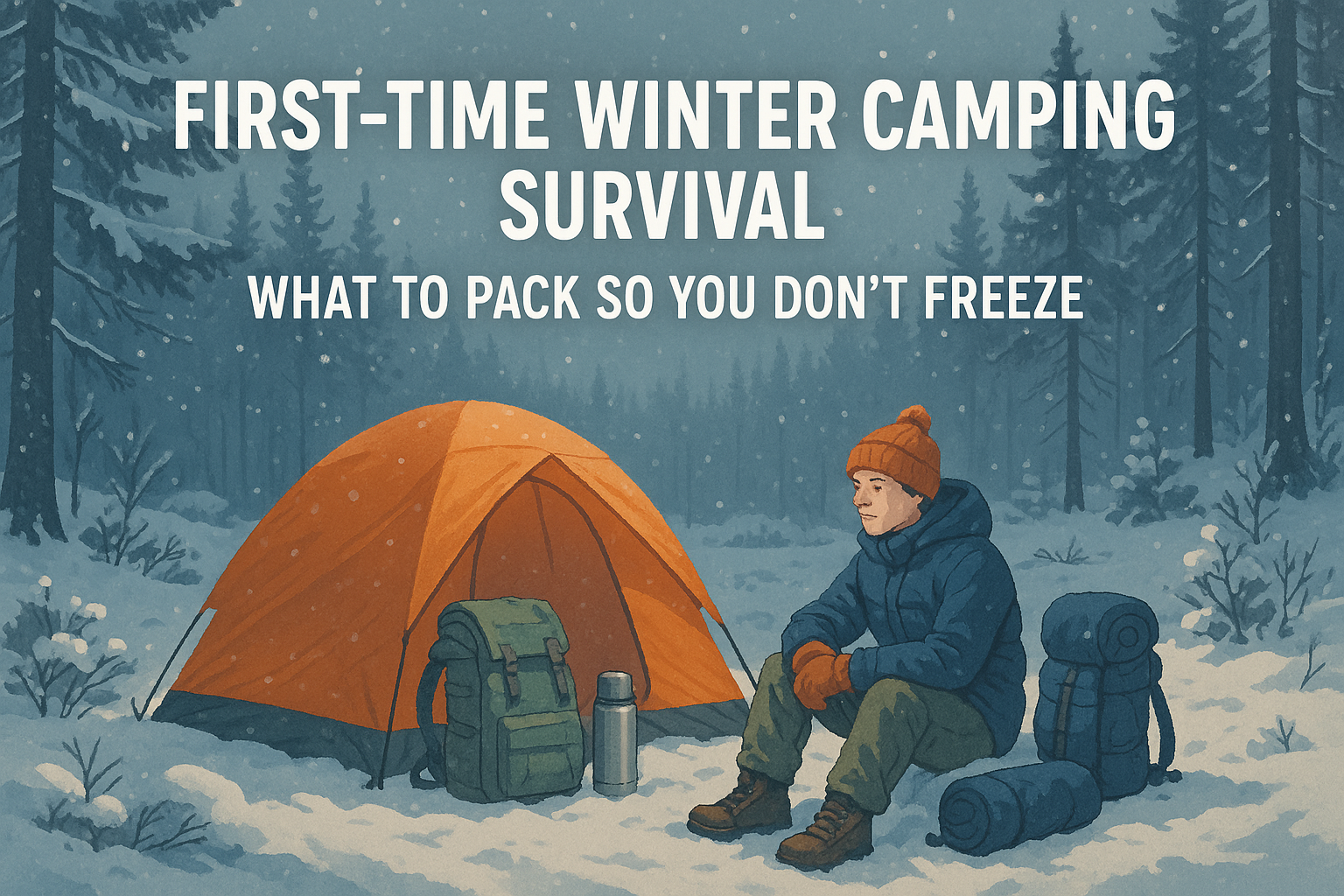Winter camping is romantic — until the cold bites into your spine, your fingers go numb, and every breath feels like fire in your lungs.
First-time winter campers usually pack for “cold discomfort,” not survival cold.
And that mistake can cost you your life.
When temperatures drop below freezing, the margin for error disappears.
Here’s the real survival guide to what you must pack for winter camping —
if you want to make it through the night alive, not just uncomfortable.
❄️ Rule #1: You’re Packing for Body Heat Retention, Not Comfort
Forget “warm clothes” or “good gear.”
You are packing to trap body heat like your life depends on it — because it does.
Everything you pack must do one (or more) of these things:
- Block wind
- Trap warmth
- Prevent moisture escape
- Create insulation barriers
- Allow smart layering without sweating
If it doesn’t help survival directly, it’s dead weight.
🎒 Critical Non-Obvious Survival Gear to Pack
1. Vapor Barrier Liners (VBLs) — Your Invisible Armor Against Death by Sweat
Everyone talks about “layering.”
Almost no one tells first-time campers that sweating inside cold weather gear = death.
Solution:
- Pack Vapor Barrier Liners (VBL socks, VBL sleeping bag liners, or even DIY trash bags).
- Wear them over your base layers.
Why:
- Prevents moisture from evaporating off your body.
- Keeps insulation layers dry, even after minor sweating.
Pro Hack:
Use VBL socks inside normal socks to protect toes from freezing inside boots.
2. Closed-Cell Foam Pad (CCF Pad) — Not Just an Inflatable Pad
Inflatable pads are warm until they puncture.
And winter ground is an unforgiving heat sink.
Always pack:
- One closed-cell foam pad (even a cheap $20 one).
Why:
- Foam pads can’t deflate.
- You can layer your inflatable pad on top for comfort, but survival relies on the foam.
Emergency Bonus:
Can be used as a splint, snow shovel, or windbreak barrier if needed.
Ground insulation is 50% of survival. No matter how thick your sleeping bag is — without insulation underneath, you will freeze.
3. Wool Buff or Shemagh (Neck Gaiter) — Microclimate Management
Your neck is the most vulnerable heat loss point most people forget.
Pack:
- A wool Buff or a Shemagh (cotton scarf).
Use:
- Cover neck, face, and even layer inside jacket.
- Can be wetted for cooling if needed or wrapped tightly for extreme wind blocking.
Bonus Trick:
Stuff the Buff with dry grass to create an emergency insulative face mask if your main gear fails.
4. Double Bivy System — Not Just a Sleeping Bag
No sleeping bag on Earth will save you from exposure if you’re wet or if the wind cuts through your shelter.
Pack:
- Sleeping Bag + Waterproof/Breathable Bivy Sack
- (Example: SOL Escape Bivvy, Gore-Tex bivy covers)
Why:
- Bivy traps body heat far tighter than a sleeping bag alone.
- Shields against condensation soaking your bag overnight.
Real Survival Tip:
Sleeping bag rating lies. Shelter quality determines if you survive.
5. Fire Triangle Kit — Guaranteed Ignition Materials
Fires aren’t optional — they are survival.
Pack a real three-point fire kit:
- Ferro rod (sparks when wet)
- Waterproof matches
- Wax fire starters (or Vaseline-soaked cotton balls)
Field Drill:
Practice building a fire blindfolded and gloved — because your fingers may not work properly in extreme cold.
Bonus:
Always keep a mini kit inside your clothing, not just your backpack — in case of emergency separation.
6. Hard-Shell Jacket and Pants (Non-Insulated) — Not “Warm” Gear
Most beginners buy insulated jackets and think they’re ready.
Big mistake.
Pack:
- Lightweight hard-shell waterproof, windproof outer layers.
Why:
- Insulated jackets trap moisture — you sweat and then freeze.
- Shells block wind and moisture while letting you layer smart underneath.
Survival Law:
Warm is earned by smart layering, not pre-insulated clothing.
7. Heat Packs (Chemical Hand and Foot Warmers) — Emergency Blood Flow Boost
Real survival isn’t about staying cozy.
It’s about keeping blood circulating to fingers and toes to prevent frostbite.
Pack:
- 4–6 chemical hand and foot warmers.
Emergency Use:
- Keep inside gloves and boots.
- Place near carotid arteries (neck) or femoral arteries (thighs) if you start shivering uncontrollably.
8. Metal Cup + Multi-Fuel Stove — Boil, Melt, Survive
Without heat or water, you die faster than you’d think.
Always carry:
- Stainless steel cup (single-wall for boiling)
- Multi-fuel stove (works with white gas, diesel, or gasoline)
Why:
- Melt snow for drinking water without hypothermia risk.
- Make emergency hot drinks (tea, broth) to spike core temperature.
Field Tip:
Boil water, pour it into a sealed bottle, and put it inside your sleeping bag = survival-grade radiant heat source.
9. Redundancy in Socks and Gloves — Triple Pairs Minimum
Your hands and feet will lose the battle first.
Pack:
- Minimum of three pairs each:
- Thin liner gloves
- Insulated waterproof gloves
- Heavy-duty mittens
- Same for socks: liner socks, insulating socks, backup pair.
Reason:
- Wet socks or gloves are death sentences.
- Spares allow rotation between drying and use.
Pro Hack:
Sleep with socks and gloves inside your sleeping bag to keep them warm for morning use.
🛡 Survival Packing Checklist Recap:
✅ Vapor barrier liners
✅ Closed-cell foam pad + inflatable pad
✅ Wool Buff or Shemagh
✅ Bivy sack + sleeping bag combo
✅ Fire triangle kit
✅ Hard-shell jacket and pants
✅ Chemical heat packs
✅ Stainless steel cup + multi-fuel stove
✅ Redundant socks and gloves (triple pairs)
🌄 Conclusion: Pack for the Cold That’s Coming, Not the Cold You Hope for
Winter doesn’t care if it’s your first camping trip.
It doesn’t give second chances.
You pack smart — or you freeze dumb.
If you bring the right survival gear and understand what really kills you —
Moisture, ground loss, wind, evaporation, and blood flow loss —
you can endure brutal nights and walk out stronger.
Pack to survive, not just to camp.

